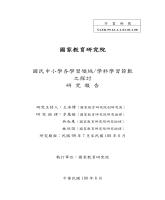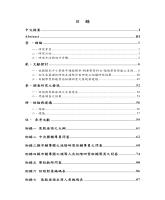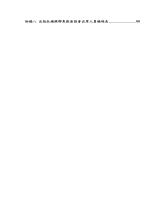國民中小學各學習領域/學科學習節數之探討 研究報告
| 研究計畫及報告 | |
| 計畫類型 | 整合型計畫 |
| 計畫名稱 | 國民中小學各學習領域/學科學習節數之探討 研究報告 |
| 英文題名 | The Investigation on the Learning Periods of Each Learning Field/Subject in Primary Schools and Junior High Schools |
| 整合型計畫名稱 | 「中小學課程發展之相關基礎性研究」區塊研究一整合型研究(二):國民中小學課程綱要之領域/學科架構研究 |
| 共同主持人 | 秦葆琦;楊龍立 |
| 計畫主持人 | 王浩博 |
| 研究者 | 研究助理: 李慧娟;吳淑惠;林欣誼 |
| 執行單位 | 國家教育研究院 |
| 年度 | 99 |
| 語文 | 中文 |
| 關鍵詞 | 國民中小學;課程綱要;學習節數 |
| 關鍵詞(英) | primary and junior high schools;curriculum guideline;learning periods |
| 摘要 | |
| 英文摘要 | I.The research purpose The background of this reseach are as follows : 1.Since 2008,the basic research about the future curriculum guideline has started it’s engine and has finished those integrated researches of section one and section 2.In 2010,the major work is to integrate the results of those researches and to prepare the draft of the next curriculum guideline. 2.In order to make the draft more correspond with the needs of time,should the learning periods of the learning fields in the future curriculum guideline be adjusted?If the answer is ‘yes’,how to do the adjustment?does it have any ideology or practical experience to base on ? All of these need to have further investigation. The purpose of this research are : 1.To explore the learning periods of each learning field or subject and its related researches. 2.To propose the learning periods of each learning field or subject for the refernce of future decision making about curriculum guideline. II.The research method This research adopts the methods of literature analysis,questionnaire survey ,focus group discussion and interview. 1. literature analysis This study will base on the major findings and suggestions of the finished integrated researches and other related reseaches to analyze and conclude. 2. Survey a. Focus group discussion To invite different groups of people to attend the discussion to collect the opinions about the learning periods.These groups include the experts and scholars from consulting team,the editors of textbooks,the consulting teachers from central government and local government,the parent groups, and teachers from special schools. b. Interview To interview the scholars and experts that had attended the formation of one to nine curriculum guideline. c. Questionaire investigation In order to get the opinions of the teachers from the basic level,this study questionaire the teachers from consuting groups and the common schools to get empirical suggestions. III.Conclusion and suggestion The conclusions of this research are as following: 1. The total number of learning periods in a year keeps the same with the present curriculum guideline. 2. Both the percentage mode and period mode are all suitable for the future distribution of learning periods. 3.The ratio of the learning periods for each learning field/subject in each grade or stage should consider the importance and function of each learning field /subject in that stage.And it should not adopt the present straight line mode. 4.The present way that let the school can distribute the learning periods within the limit of each field/subject should not be changed. 5.The establishment of the flexible learning periods with it’ s ideal nature and functional nature has the necessity of maintenance. 6.Some fields/subjects should be increased the number of the learning period.:mandarin,mathematics,social studies,nature and living technology,english,health and physical education etc.. Finally,this research tries to propose a learning period framework for the future curriculum guideline. 1. The total instruction days are 200 days(not include the national holidays and the weekend).The term has 20 weeks and each week has 5 instruction days. But it should follow the rule of Personnel Administration Bureau of the Executive Yuan. 2. The learning periods are divided into two categories: the learning periods of the learning fields and the flexible learning periods. 3. Each period instructs 40-45 minutes in principle( primary school 40 minutes and junior high school 45 minutes ).However,every school can flexibly adjust the number of term weeks,the length of period,and the combination of class according to the need of curriculum implementation and student’s learning progress. 4. The flexible learning periods are planned by schools to do the activities for the whole school and the whole grade,to enforce the curriculums or activities designed according to the school’s features,to arrange the selected learning periods,to practice the remedy teaching,and to do the activities of classroom guidance, moral education or student’s self learning etc.. 5. If the learning activity covers two more learning periods, the number of learning periods could be separately counted into each learning field. 6. In the principle of having fully instructed the learning periods,the committee of school curriculum development can decide and arrange the learning periods for every learning field in every week. 7. The hours of the tutor , the mid-noon rest and the cleaning activities are not included into the learning periods.The activities of students non-learning periods are arranged by school. IV.The nature of the research result and the suggestion for its implication The result of this research is only provided for the policy refernce of related education administration.It should have further and deeper consultation before putting into practical policy. V.The suggestion for the present or future education policy Due to the enforcement of 12 year basic education in 2014,the National Academy for Educational Reseach is responsible for the rearch of curriculum and should offer an suggestion report.The result of this research can also be included as a refernce. |
| 授權狀態 | 已授權 |



